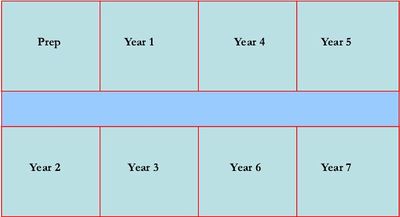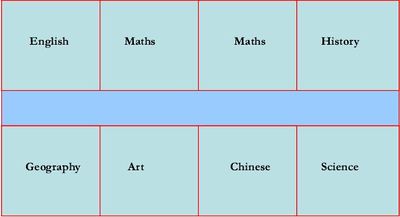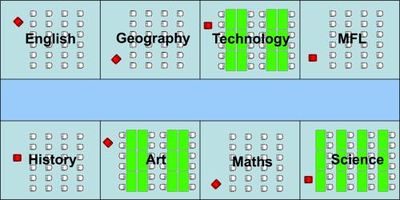Labels and Spaces
From DT Online
Its all in a name?
Think about what you should call each subject or group of subjects. What will you call the spaces in which each of these are taught? Does it matter?
- Consider for example 'Woodwork and Metalwork as opposed to Handicraft or Design and Technology; is Domestic Science the same as Home Economics, Cooking or Food Technology? It is clear that the name does imply some aspects of the subjects being taught.
- Is a Studio the same as a Workshop and what would you expect to see in a Factory Floor? Does Learning Space suggest something more flexible than Classroom?
- Which subjects would you expect to combine in a Design Faculty as opposed to a Technology Faculty? Is Zone a more useful term than Faculty?
‘Cells and Bells’
If learning spaces are all the same shape and size perhaps they constrain too much the variety of teaching styles that can make learning fun?
- Traditional primary school classroom block
The illustration shows a traditional primary school classroom block. Each classroom is the same size, same shape and are aligned along a corridor.
- do you know of any schools designed like this?
- what does it say about the basis on which classes are organised?
- could classes be organised differently - eg by ability reached, mixed ages or other ways?
- how easy would it be to combine classes for a topic, presentation or project?
- what does it say about the size of class in each year group?
- what does it say about the type of activities each year group do?
- do all activities require the same shape and size of space?
If the prompts above give you cause to question the effectiveness of this simple traditional arrangement, what would you do differently?
- Traditional secondary school teaching block
The illustration shows a traditional secondary school teaching block. Each classroom is the same size, same shape and are aligned along a corridor.
- do you know of any schools designed like this?
- what does it say about the basis on which subject groups are organised?
- how easy would it be to combine subject groups for a topic, presentation or project?
- what does it say about the group size for different subjects?
- what does it say about the type of activities each subject involves?
- do all activities require the same shape and size of space?
If the prompts above give you cause to question the effectiveness of this simple traditional arrangement, what would you do differently?
- Influence of spaces on teaching styles
The illustration shows a traditional classroom block. Each same size classroom is furnished with 24 pupil desks and chairs plus one teacher chair.
- does this limit the ways in which a teacher can interact with a class?
- is the number of ways the class can be set out restricted?
- are all subjects taught the same way?
- do all subjects need the same space?
- how easy would it be to organise group work for example?
- what would happen if more than one teacher was needed?
- how easy is it for teachers or pupils to move about?
If the prompts above give you cause to question the effectiveness of this simple traditional arrangement, what would you do differently?


